|
FAQs on Anemones of the
Caribbean/West Atlantic: Misc., & Unidentified
Spp.
Related Articles: Anemones of
the Tropical West Atlantic, Condylactis Anemones, Anemones,
LTAs, Colored/Dyed Anemones,
Related FAQs: Atlantic Anemones 2, Condylactis, Tropical West
Atlantic (TWA) Anemone Identification, TWA Anemone
Behavior, TWA Anemone
Compatibility, TWA Anemone
Selection, TWA Anemone
Systems, TWA Anemone
Feeding, TWA Anemone
Disease, TWA Anemone
Reproduction,
FAQs by Genus: Actinoporus, Arachnanthus, Bartholomea, Condylactis
(see below), Epicystis, Lebrunia, Sticholdactyla helianthus, Viatrix,
Anemones, Anemones 2,
Clownfishes & Anemones,
Anemone Systems, Anemone
Lighting, Anemone
Reproduction, Anemone
Identification, Anemone
Compatibility, Anemone
Selection, Anemone Behavior,
Anemone
Health, Anemone
Placement, Anemone
Feeding,
|

 |
 |
New Print and
eBook on Amazon:
Anemone Success
Doing what it takes to keep Anemones healthy long-term
by Robert (Bob) Fenner
|
Rock flower nems
3/18/17
Hey guys how has it been.
<Fine Tom; thanks>
Have a quick one about some rock flower nems that we have been getting and
shipping in. We are having a large number melting the second or third day in.
Cal 440, Mag 1350, alk 8 no3 5. They seem to be expelling a large
amount of why looks like green brown stringy material almost like a small hay.
<Mmm; trouble>
They are still solid feeling when introduced to the system.
<Alive up till then likely>
Could they have an issue with the substrate ?
<Doubtful... something/s else. Are they shipped one to the bag? Are their
pedicles intact; i.e., not torn?>
We acclimate them with :30 float and :30 drip.
<I'd be dosing (over; like three plus times) with iodide-ate and lowering the
spg of the acclim. water a thousandth or two>
Have kicked around putting them in a bare bottom and doing water changes ever
hour till they quit expelling that material.
What chemicals can be used to help with these issues
<As above... plus poss. a simple/hexose sugar... as detailed by Hans Hass
decades back and myself in recent ones>
Thanks again
Tom smith
Aquascape Chicago
<Welcome. Bob Fenner>
Re: Rock flower nems
3/18/17
<Can't read this>
Re: Rock flower nems
3/18/17
Sorry about that
The nems all looked in tack in the bags and were shipped 5 per med sized bag.
<Mmm; I'd only ship one per... ALWAYS>
Just found the writing on the simple sugar treatment
What type is sugar works
Cane
Corn syrup
Simple cheap white ?
<Glucose is best... look for this at the supermarket for folks that do canning.
Bob Fenner>
|
Need help identifying anemone -- 03/18/10
I've attached three pictures of a strange anemone. It lives
in the sand at about the 10 foot depth, and is usually covered
with sand during the day (see picture #1), although sometimes I
can see it, especially in the late afternoon. At night it comes a
little above the sand and looks like picture #2. When my dive
light attracts a worm or small fish to the anemone, it closes up
as in picture #3.
These pictures were taken on Bari Reef on Bonaire, Netherlands
Antilles.
It is about 1 1/4 to 1 1/2 inches in diameter. Any idea of what
it is?
Thanks,
Marge Lawson
<I've been to Bonaire a few times... it is a treasure for
divers... but have not seen this beautiful anemone (though do
occasion Cerianthus in the shallow sands... in about the same
environment, quite often). I've looked in my references, on
the Net, and I can't place this animal. I would send your
images along to Daphne Fautin (Hexacorallians of the world .com)
in the hope that she might know, or be able to find you someone
who does. Thank you for sharing. Bob Fenner>
|
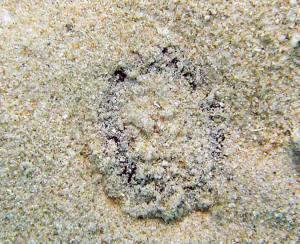 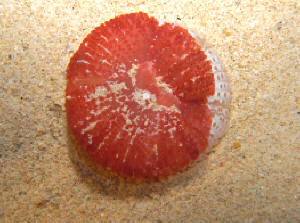
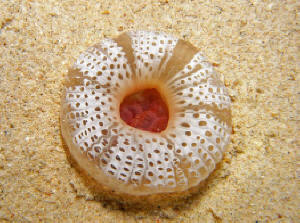 |
|
Re: Feeding and care of Calliactis tricolor
anemone 1/19/07 Hi Bob - Thank you so much for
your reply. It was very helpful. <Welcome> In the interim..
The two largest anemones went back to the ocean before we headed
inland (taking up too much space). The other 6 have
continued to feed well.. ammonia was ~ 0.25-0.5ppm. <Do watch
this... no feeding if it approaches 1.0 ppm> Jan 9th they
consumed a whole shrimp that had been minced.. <Too much>
and by the 14th the ammonia had spiked to 8ppm (or higher,
yikes!). <... dangerous> We're letting the tank
complete its cycling. We transferred all inhabitants to a clean
container with regular input of fresh saltwater. 4 anemones
looked none the worse during this time. Two had developed 1-2
translucent/depigmented areas in the column and have been
segregated into individual containers. The areas were covered in
a lot of mucoid material though the underlying tissue was still
firm -- attached images show one of the areas beneath my fingers
(sorry for the poor image quality). They have continued to feed
and adhere to shells during this time. The areas are not getting
worse, nor do they appear to be healing, though pigmentation has
started to return. Ammonia has stayed at 0ppm in our temporary
refugium. <Good> I'm curious what causes such lesions?
<"Environmental stress"> I swabbed the afflicted
areas + normal skin from healthy anemones, & Gram stained the
material (I'll admit that my day job involves a lot of
biochemistry and microbiology). Didn't see anything obvious
if its something bacterial or fungal. <Mmm, no, not until
decomposition usually> <A pleasure to share. Bob
Fenner>
|
|
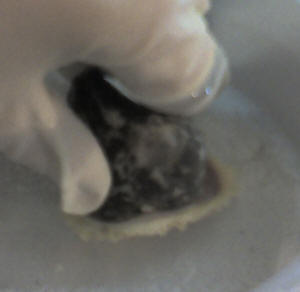
|
| Re: Feeding and care of
Calliactis tricolor anemone - 02/09/2007 Just wanted to say
thanks again for your help. Bonus pictures attached ;)
<Neat!> After waiting 2 weeks for the tank to cycle with just
live sand, we invested in 2 lbs cured live rock, which dropped the
ammonia to 0, almost overnight. <Ah, good> Nitrites range
from 0-1ppm and nitrate 5-10ppm with 10% water changes over the
week. <Very good> Everyone's back in the Eclipse tank.
The anemone we found with a desiccated pedal disk adhered to a
shell a few days later while being moved during cleanup of some
goo (skinny one in the back RH corner). The anemone in
front, named "Goldenrod" by my husband, is definitely the
tank poser (2nd picture). <Heeee!> Cheers.. Lynn AG
<Thanks for sharing. BobF, who really likes the Tiger Cowry
shell> |
|
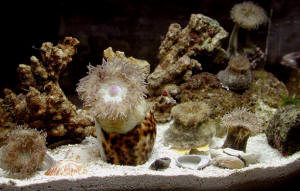
|
DomRep Sea Anemone Identification 10/5/05 Hi!
<Hello Uli> I found your website http://www.wetwebmedia.com/marine/inverts/cnidaria/anthozoa/twaanemones.htm
looking for help. I need to identify an anemone. Please find jpgs
attached. I could not yet find it anywhere! By the way: I was not
the photographer, "it" was not touched to see a reaction,
all we have is the photo shot in the Dominican Republic. Any
idea?
<Appears to be an Actinodendron species. Mr. Fenner
may have some input here. James (Salty Dog)>
<<I concur. RMF>> Thanks a
lot! <You're welcome> Uli
Biologist
Germany |
|
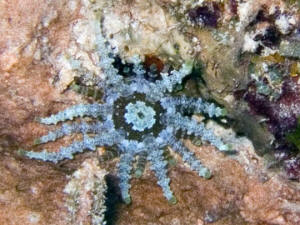
|
Anemone ID Hi Steve <Anthony with the follow up>
I wrote to you about the black spot on my deceased yellow tangs . Well
since their demise I purchased a Fireball Angel , half orange and half
blue horizontally . I had the fish for three days and it died . The pet
shop had the fish for a month prior with no problems . I will give you
a run down of my tested parameters after the death . PH - 8.31 at 7:00
PM Nitrite - 0 Nitrate - < 10ppm CA - 480 ppm "a little
high" Temp - 78 Salinity - 1.024 Alkalinity - 3.5 meg/L Borate -
1.5 meg/L Carbonate - 2.0 meg/l Magnesium - 1300 ppm The tank has no
other fish inhabitants other than two blue Chromis . I also have 110
lbs of live rock . The rock has many mushroom corals and feather
dusters , I also noticed a small anemone , not a aphasia , the base is
red and the tentacles are white . Any idea on I.D.? <it
reminds me of some Atlantic/Gulf species... is your rock aquacultured
Atlantic in origin?> Also I have about a dozen large snails and a
dozen large blue leg hermits . I refuse to purchase any more fish,
because soon I will be known as Dr. Death . Any help would be
appreciated . Richard <do keep and medicate all new fish in a
quarantine tank for 4 weeks before adding them to your display. Even
though the pet store had the fish for a month... was it in a system
that never had a new fish added to it? Or cold there have been a new
shipment of fish that were added to that system within two weeks prior
and could have carried a disease that didn't express itself yet. No
exceptions to the quarantine rule! All new fish QT in your home
regardless before adding to the display. Best regards, Anthony
Calfo>
| Unidentified Anemone Hi, I recently bought
100 lbs. of live rock from Harbor Aquatics for my 125 gallon.
(Previously cycled with live sand) In one of the caves lives a
strange anemone that nobody can seem to identify. (attached)
<not a bad picture but a bit dark. Still...> I was under the
impression that anemones like strong light, <not all by
any stretch of the imagination... many nearly or clearly
aposymbiotic (require organismal and absorptive feeding for
life)> but this guy only came out of the cave once at night, and
when the lights came on in the morning, it went back into the cave.
Can you tell me what kind of anemone it is, and what is the best
way to care for it? Thanks <Not clear to me what species it is
but definitely resembles many of the tiny Atlantic cave dwellers
known to be weakly photosynthetic or not at all. Do feed at least
weekly with finely shredded meats of marine origin. Enjoy!
Anthony> Jonathan Steere |
|
|

